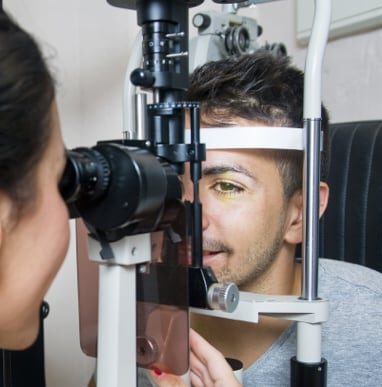Vertigo can be a concerning and unsettling experience, especially when it strikes while you’re behind the wheel. For many drivers who experience vertigo, understanding the triggers and managing the symptoms is crucial for both safety and peace of mind.
When there is a gap between the movement around you and how your brain processes that movement, you may experience dizziness or vertigo. Frequent changes in head position and the rapid movement around you can cause vertigo while driving.
Your peripheral vision and the way your eyes work together as a team can also impact the way you process visual information. Fortunately, vision therapy can train the brain to better respond to visual stimuli.
What Is Vertigo?
Vertigo is a sensation of spinning or dizziness that can affect your balance and orientation. It’s often caused by issues in the inner ear or the brain. While vertigo itself is a symptom, not a condition, it can be associated with various medical conditions such as benign paroxysmal positional vertigo (BPPV), Meniere’s disease, or vestibular neuritis.
Causes of Vertigo While Driving
Visual Triggers
Normally, our visual system and our vestibular system (a part of our inner ear) work together to regulate our balance. The link between those two systems is called the vestibulo-ocular reflex (VOR). When our VOR isn’t functioning correctly, it can cause problems like dizziness and vertigo.
Driving requires constant visual scanning and processing of moving objects, which can be overwhelming for some people. Since you have to process these objects faster while you’re driving than you normally would when walking, the extra strain on your VOR can make the dysfunction worse, leading to vertigo.
Motion Sickness
One of the most common reasons people experience vertigo while driving is motion sickness. Motion sickness occurs when there’s a disconnect between what you see and what your inner ear senses. When you’re driving, your eyes, ears, and body send conflicting information to your brain, leading to dizziness and nausea.
Inner Ear Issues
The inner ear plays a crucial role in maintaining balance. Conditions like benign paroxysmal positional vertigo (BPPV), where small crystals in the inner ear become dislodged and move into the ear canals, can trigger vertigo. The constant motion and vibrations while driving can exacerbate these symptoms.
Anxiety and Stress
Anxiety and stress can exacerbate vertigo symptoms. The fear of experiencing vertigo while driving can create a cycle in which anxiety about the possibility of vertigo actually triggers feelings of dizziness. This type of vertigo is often referred to as psychogenic vertigo.
How to Manage Vertigo While Driving
Vision Therapy
Since vertigo is caused by the way the eyes, the inner ear, and the brain function together, vision therapy can be a helpful treatment for vertigo. Vision therapy retrains your eyes to work more effectively together by helping to re-synchronize your ocular system with your vestibular system. This can target vertigo at its root instead of simply managing the symptom.
Neurolens
Since vertigo is caused by a dysfunction linked to the nervous system, Neurolens can be an effective option to treat the visual causes of vertigo. Neurolens uses contoured prisms to help relieve eye misalignment and reduce pressure on the trigeminal nerve, which controls the muscles around the eyes and is responsible for your eye alignment.
Frequent Breaks
If you start to feel dizzy while driving, pull over to a safe location and take a break. Walk around if possible to help reset your inner ear balance and reduce vertigo symptoms.
Focus on a Fixed Point
If it is safe to do so, keeping your eyes on a fixed point in the distance can help reduce the sensory overload that triggers vertigo. Avoid looking at moving objects along the roadside. Of course, don’t let this take away from staying aware of your surroundings while you’re driving—if it doesn’t help right away, it’s safer to pull over instead.
Stay Hydrated and Eat Light
Dehydration and heavy meals can increase vertigo symptoms. Make sure you’re well-hydrated and eat light, healthy snacks before and during your drive.
Use Anti-Motion Sickness Aids
Over-the-counter medications can help manage motion sickness and reduce vertigo symptoms. Always consult with your healthcare provider before taking any medication.
Practice Relaxation Techniques
Deep breathing exercises, meditation, and progressive muscle relaxation can help manage anxiety and reduce the likelihood of vertigo attacks. Incorporating these techniques into your daily routine can provide long-term benefits.
Consult a Healthcare Professional
If you frequently experience vertigo while driving, it’s essential to consult a healthcare professional. An optometrist can personalize a vision therapy program to help train your eye function.
They may also refer you to a doctor if your vertigo is caused by underlying problems in the ears, brain, or nervous system.
Leave Your Vertigo in the Rear-View Mirror
Experiencing vertigo while driving can be both frightening and dangerous. Understanding the possible causes and implementing effective management strategies can help mitigate the risks. If vertigo persists, it’s important to seek medical advice for a more personalized approach to treatment.
Vision Care Center is here to help you address the cause and manage the symptoms of vertigo so that you can drive safely. If you’re concerned about experiencing vertigo while driving, don’t hesitate to book an appointment with us!












